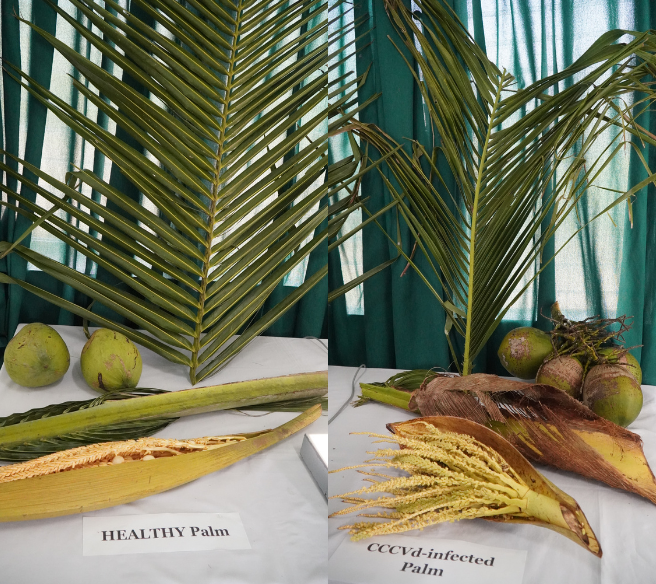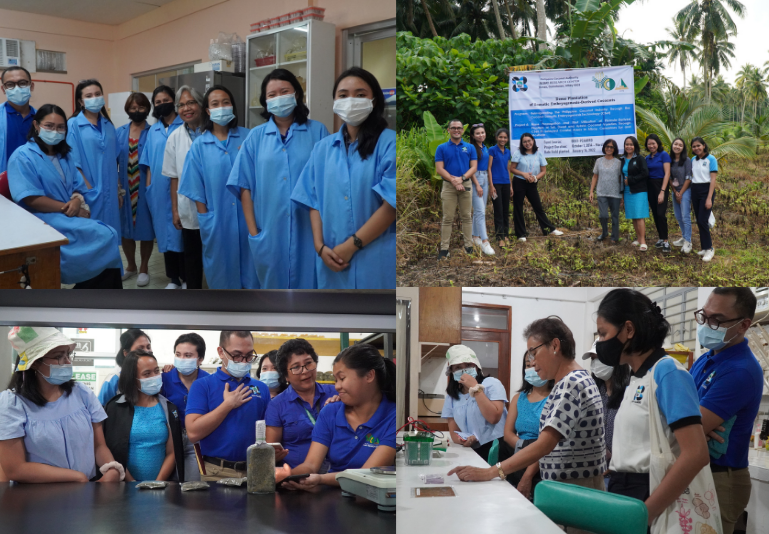Two new projects under the program, “Virology and Vaccine Institute of the Philippines (VIP): Development of Mitigating Strategies for the Coconut Cadang-cadang Threat,” were formally launched through an inception meeting. The activity was recently conducted by the Philippine Council for Agriculture, Aquatic and Natural Resources Research and Development of the Department of Science and Technology (DOST-PCAARRD) at the Philippine Coconut Authority-Albay Research Center (PCA-ARC) in Guinobatan, Albay.
Coconut cadang-cadang viroid disease (CCCVd) is a slowly progressive disease that once instigated, can wipe out a coconut plantation. With only a few available management measures such as elimination through cutting and burning, farm sanitation, and strict quarantine restrictions, the disease continues to be a major threat to the Philippine coconut industry.

Healthy vs. CCCVd-infected coconut shown at the inception meeting. (Image credit: Crops Research Division, DOST-PCAARRD)
According to the program, CCCVd-infected coconuts show chlorotic or yellowing of leaves, scarified and rounded newly developing nuts, stunted and sterile inflorescence, as well as few and short fronds. Infection could lead to the coconut’s eventual death. These symptoms are found to be similar to physiological changes caused by various biotic and abiotic factors, making the disease diagnosis difficult.
Studies on the resistance mechanisms to cadang-cadang and coconut-CCCVd interaction are also found to be limited.
These gaps are expected to be addressed by the new projects being implemented by PCA-ARC under the Grants-in-Aid (GIA) funding of DOST-PCAARRD.
The project, "Transcriptomic Analysis of Healthy and Cadang-cadang-infected Coconut Palms," led by Ms. Maria Czet L. Fulleros, aims to elucidate possible mechanisms of the coconut’s host response to infection through identification of differentially expressed genes.
On the other hand, the project, "Application of Antisense Technology for the Coconut Cadang-cadang Disease: A Proof of Concept Study," is expected to optimize the antisense technology protocol for the induction of resistance to CCCVd, which can be utilized further for breeding purposes.
Dr. Cristeta A. Cueto, program leader, highlighted that no coconut cultivar has been found to be resistant to CCCVd, making the development of anti-viroid strategies through biotechnological tools an appealing option to control the spread of the disease.
During the inception meeting, project details were refined and clarified, roles of agencies involved were discussed, and the monitoring and evaluation (M&E) plan and GIA guidelines were presented.

DOST-PCAARRD representatives during the laboratory and field visit at PCA-ARC. (Image credit:Crops Research Division, DOST-PCAARRD)
The meeting was attended by the project team from PCA-ARC, representative from DOST Region V-Provincial S&T Office (DOST V-PSTO)-Albay, Ms. Catherine Comia, and key personnel from the Crops Research Division (CRD) of DOST-PCAARRD led by Director Leilani D. Pelegrina with the Industry Strategic S&T Program (ISP) Manager for Coconut, Ms. Alissa Carol M. Ibarra.
The CRD Monitoring and Evaluation Team also visited PCA-ARC’s facilities such as the CocoServe, Coconut Somatic Embryogenesis Technology (CSet) Tissue Culture Laboratory, Molecular Biology Laboratory, Entomology Division facilities, and the field planting site of the CSet-derived coconuts.

